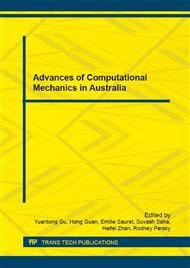p.506
p.512
p.518
p.524
p.530
p.535
p.541
p.547
p.553
Representative Volume Element-Based Modelling of Closed-Cell Aluminum Foams
Abstract:
This paper presents a representative volume element (RVE)-based modelling method to capture the mechanical behaviour of aluminum foams under compressive loadings. Octadecahedron is selected as a geometric basis shape to form closed cells of the aluminum foams in the microstructured RVE model to simulate the mechanical behaviour under compressive loadings. The stress-strain relationship obtained from the numerical modelling is compared to that from experimental study and agreements between these results demonstrate the validity of the proposed RVE model. Through observing the deformation evolution of cells during a compressive loading process, the failure modes of aluminum foams are identified and analysed using the proposed RVE model. Further the influence of strain rate on the mechanical behaviour of aluminum foams under compressive loadings is numerically studied via a parametric study.
Info:
Periodical:
Pages:
530-534
Citation:
Online since:
July 2016
Authors:
Price:
Сopyright:
© 2016 Trans Tech Publications Ltd. All Rights Reserved
Share:
Citation:


